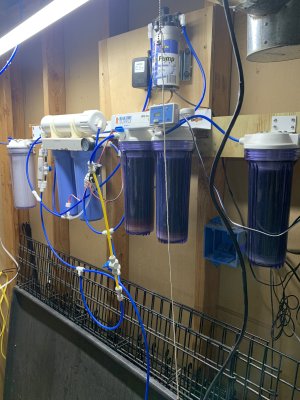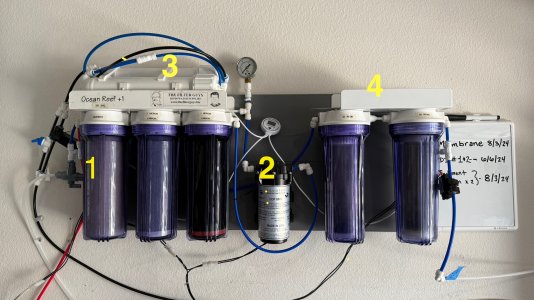Raptor72
Active member
@griss, this one is for you. I appreciate the advice you’ve put out there before and now I’m in need of it.
I’ve had my RO/DI system up and running for years and after reading some posts about the subject I’m wondering if I have mine set up to be the most productive. Please bear with my description as I try to describe the setup.
1- Cold water source from water heater
2- Boost pump
3- Sediment
4- 5 Mi. carbon
5- 1 Mi. carbon
6- Pressure gauge
7- Auto shutoff or splitter (it’s been a while since I installed)
8- 3 way valve ( to RO and RODI tanks) RODI valve to double DI resin to container (pump pressure switch after DI resins
Here’s where it gets a bit confusing to describe
9- Splitter to membrane set
10- Membrane to a y, manual flush on one, auto flush on other, back to y and single one again (see pic)
11- Discharge
I hope that’s clear as mud. I’d also like to color code the lines for their intended use (black, red, yellow).




I’ve had my RO/DI system up and running for years and after reading some posts about the subject I’m wondering if I have mine set up to be the most productive. Please bear with my description as I try to describe the setup.
1- Cold water source from water heater
2- Boost pump
3- Sediment
4- 5 Mi. carbon
5- 1 Mi. carbon
6- Pressure gauge
7- Auto shutoff or splitter (it’s been a while since I installed)
8- 3 way valve ( to RO and RODI tanks) RODI valve to double DI resin to container (pump pressure switch after DI resins
Here’s where it gets a bit confusing to describe
9- Splitter to membrane set
10- Membrane to a y, manual flush on one, auto flush on other, back to y and single one again (see pic)
11- Discharge
I hope that’s clear as mud. I’d also like to color code the lines for their intended use (black, red, yellow).



